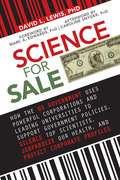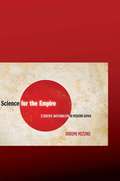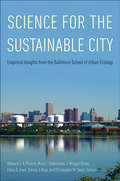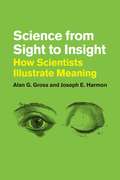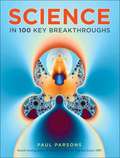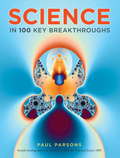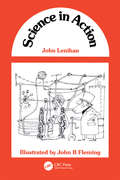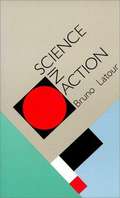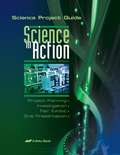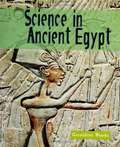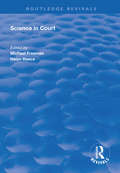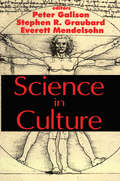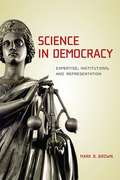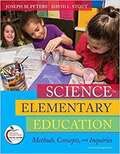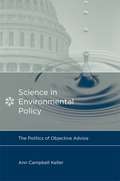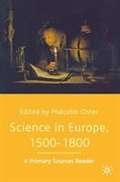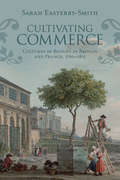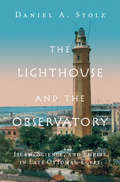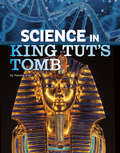- Table View
- List View
Science for Sale: How the US Government Uses Powerful Corporations and Leading Universities to Support Government Policies, Silence Top Scientists, Jeopardize Our Health, and Protect Corporate Profits
by David L. LewisWhen Speaker Newt Gingrich greeted Dr. David Lewis in his office overlooking the National Mall, he looked at Dr. Lewis and said: "You know you're going to be fired for this, don't you?" "I know," Dr. Lewis replied, "I just hope to stay out of prison." Gingrich had just read Dr. Lewis's commentary in Nature, titled "EPA Science: Casualty of Election Politics." Three years later, and thirty years after Dr. Lewis began working at EPA, he was back in Washington to receive a Science Achievement Award from Administrator Carol Browner for his second article in Nature. By then, EPA had transferred Dr. Lewis to the University of Georgia to await termination--the Agency's only scientist to ever be lead author on papers published in Nature and Lancet.The government hires scientists to support its policies; industry hires them to support its business; and universities hire them to bring in grants that are handed out to support government policies and industry practices. Organizations dealing with scientific integrity are designed only to weed out those who commit fraud behind the backs of the institutions where they work. The greatest threat of all is the purposeful corruption of the scientific enterprise by the institutions themselves. The science they create is often only an illusion, designed to deceive; and the scientists they destroy to protect that illusion are often our best. This book is about both, beginning with Dr. Lewis's experience, and ending with the story of Dr. Andrew Wakefield.
Science for Sale: How the US Government Uses Powerful Corporations and Leading Universities to Support Government Policies, Silence Top Scientists, Jeopardize Our Health, and Protect Corporate Profits
by David L. LewisFor the first time in paperback and with a new introduction. Discover how and why the government is corrupting scientific research.When Speaker Newt Gingrich greeted Dr. David Lewis in his office overlooking the National Mall, he looked at Dr. Lewis and said: "You know you’re going to be fired for this, don’t you?” "I know,” Dr. Lewis replied, "I just hope to stay out of prison.” Gingrich had just read Dr. Lewis’s commentary in Nature, titled "EPA Science: Casualty of Election Politics.” Three years later, and thirty years after Dr. Lewis began working at EPA, he was back in Washington to receive a Science Achievement Award from Administrator Carol Browner for his second article in Nature. By then, EPA had transferred Dr. Lewis to the University of Georgia to await termination—the Agency’s only scientist to ever be lead author on papers published in Nature and Lancet.The government hires scientists to support its policies; industry hires them to support its business; and universities hire them to bring in grants that are handed out to support government policies and industry practices. Organizations dealing with scientific integrity are designed only to weed out those who commit fraud behind the backs of the institutions where they work. The greatest threat of all is the purposeful corruption of the scientific enterprise by the institutions themselves. The science they create is often only an illusion, designed to deceive; and the scientists they destroy to protect that illusion are often our best. This book is about both, beginning with Dr. Lewis’s experience, and ending with the story of Dr. Andrew Wakefield. This new edition, now for the first time in paperback, features a new introduction by the author.
Science for the Empire
by Hiromi MizunoMizuno (history, U. of Minnesota) explores the relationship between discourses of science, nationalism, and modernity in Imperial Japan, particularly focusing on competing promotions of science amongst Japanese technology-bureaucrats, Marxist intellectuals, and popular science writers engaged in the developing the new genre of popular science (tsuzoku kagagku) journalism and how those competing visions were eventually co-opted and mobilized by the Imperial state in support of wartime objectives. Annotation ©2009 Book News, Inc. , Portland, OR (booknews. com)
Science for the Sustainable City: Empirical Insights from the Baltimore School of Urban Ecology
by J. Morgan Grove Mary L. Cadenasso Steward T. A. Pickett Elena G. Irwin Emma J. Rosi Christopher M. SwanA presentation of key findings and insights from over two decades of research, education, and community engagement in the acclaimed Baltimore Ecosystem Study In a world of more than seven billion people—who mostly reside in cities and towns—the Baltimore Ecosystem Study is recognized as a pioneer in modern urban social-ecological science. After two decades of research, education, and community engagement, there are insights to share, generalizations to examine, and research needs to highlight. This timely volume synthesizes the key findings, melds the perspectives of different disciplines, and celebrates the benefits of interacting with diverse communities and institutions in improving Baltimore’s ecology. These widely applicable insights from Baltimore contribute to our understanding the ecology of other cities, provide a comparison for the global process of urbanization, and inform establishment of urban ecological research elsewhere. Comprehensive, interdisciplinary, and highly original, it gives voice to the wide array of specialists who have contributed to this living urban laboratory.
Science from Sight to Insight: How Scientists Illustrate Meaning
by Alan G. Gross Joseph E. HarmonJohn Dalton's molecular structures. Scatter plots and geometric diagrams. Watson and Crick's double helix. The way in which scientists understand the world--and the key concepts that explain it--is undeniably bound up in not only words, but images. Moreover, from PowerPoint presentations to articles in academic journals, scientific communication routinely relies on the relationship between words and pictures. In Science from Sight to Insight, Alan G. Gross and Joseph E. Harmon present a short history of the scientific visual, and then formulate a theory about the interaction between the visual and textual. With great insight and admirable rigor, the authors argue that scientific meaning itself comes from the complex interplay between the verbal and the visual in the form of graphs, diagrams, maps, drawings, and photographs. The authors use a variety of tools to probe the nature of scientific images, from Heidegger's philosophy of science to Peirce's semiotics of visual communication. Their synthesis of these elements offers readers an examination of scientific visuals at a much deeper and more meaningful level than ever before.
Science from Sight to Insight: How Scientists Illustrate Meaning
by Alan G. Gross Joseph E. HarmonJohn Dalton’s molecular structures. Scatter plots and geometric diagrams. Watson and Crick’s double helix. The way in which scientists understand the world—and the key concepts that explain it—is undeniably bound up in not only words, but images. Moreover, from PowerPoint presentations to articles in academic journals, scientific communication routinely relies on the relationship between words and pictures. In Science from Sight to Insight, Alan G. Gross and Joseph E. Harmon present a short history of the scientific visual, and then formulate a theory about the interaction between the visual and textual. With great insight and admirable rigor, the authors argue that scientific meaning itself comes from the complex interplay between the verbal and the visual in the form of graphs, diagrams, maps, drawings, and photographs. The authors use a variety of tools to probe the nature of scientific images, from Heidegger’s philosophy of science to Peirce’s semiotics of visual communication. Their synthesis of these elements offers readers an examination of scientific visuals at a much deeper and more meaningful level than ever before.
Science in 100 Key Breakthroughs
by Paul ParsonsScience in 100 Key Breakthroughs presents a series of clear and concise essays that explain the fundamentals of some of the most exciting and important science concepts you really need to know. Paul Parsons profiles the important, ground-breaking, and front-of-mind scientific discoveries that have had a profound influence on our way of life and will grow in importance with our advancing understanding.In 100 sections, this book provides an overview of the history of Western science, from astronomy and physics to geology, biology and psychology and everything in between. Starting with the origins of counting more than 35,000 years ago, Science tells a rich and fascinating story of discovery, invention, gradual progress and inspired leaps of the imagination. Many key concepts and discoveries are defined and discussed including: The circumference of the Earth, Chaos theory, Algebra, Relativity, Newton's Principia, Brownian motion, Pi, Wave/particle duality, Germ theory, The computer, X-rays, The double helix, Viruses, The human genomeReadable, informative and thought-provoking, this is the ideal introduction to cutting-edge science and the essential overview for anyone who wants to learn more about these often daunting but increasingly essential subjects.
Science in 100 Key Breakthroughs
by Paul ParsonsScience in 100 Key Breakthroughs presents a series of clear and concise essays that explain the fundamentals of some of the most exciting and important science concepts you really need to know. Paul Parsons profiles the important, ground-breaking, and front-of-mind scientific discoveries that have had a profound influence on our way of life and will grow in importance with our advancing understanding. In 100 sections, this book provides an overview of the history of Western science, from astronomy and physics to geology, biology and psychology and everything in between. Starting with the origins of counting more than 35,000 years ago, Science in 100 Key Breakthroughs tells a rich and fascinating story of discovery, invention, gradual progress and inspired leaps of the imagination. Many key concepts and discoveries are defined and discussed including: The circumference of the Earth, Chaos theory, Algebra, Relativity, Newton's Principia, Brownian motion, Pi, Wave/particle duality, Germ theory, The computer, X-rays, The double helix, Viruses, The human genome. Readable, informative and thought-provoking, this is the ideal introduction to cutting-edge science and the essential overview for anyone who wants to learn more about these often daunting but increasingly essential subjects.
Science in 100 Key Breakthroughs
by Paul ParsonsScience in 100 Key Breakthroughs presents a series of clear and concise essays that explain the fundamentals of some of the most exciting and important science concepts you really need to know. Paul Parsons profiles the important, ground-breaking, and front-of-mind scientific discoveries that have had a profound influence on our way of life and will grow in importance with our advancing understanding. In 100 sections, this book provides an overview of the history of Western science, from astronomy and physics to geology, biology and psychology and everything in between. Starting with the origins of counting more than 35,000 years ago, Science in 100 Key Breakthroughs tells a rich and fascinating story of discovery, invention, gradual progress and inspired leaps of the imagination. Many key concepts and discoveries are defined and discussed including: The circumference of the Earth, Chaos theory, Algebra, Relativity, Newton's Principia, Brownian motion, Pi, Wave/particle duality, Germ theory, The computer, X-rays, The double helix, Viruses, The human genome. Readable, informative and thought-provoking, this is the ideal introduction to cutting-edge science and the essential overview for anyone who wants to learn more about these often daunting but increasingly essential subjects.
Science in Action
by John LenihanIn Science in Action, John Lenihan shares his irrepressible enthusiasm for science. With characteristic wit and humor, he explains how science affects our daily lives in diverse areas such as medicine, poetry, politics, the environment, and the paranormal-cheerfully debunking some popular pseudo-scientific myths along the way. John Fleming's delightful cartoons add wry comment to the text, making this a book enjoyable to read time and again.
Science in Action: How to Follow Scientists and Engineers Through Society
by Bruno LatourScience and technology have immense authority and influence in our society, yet their working remains little understood. The conventional perception of science in Western societies has been modified in recent years by the work of philosophers, sociologists and historians of science. In this book Bruno Latour brings together these different approaches to provide a lively and challenging analysis of science, demonstrating how social context and technical content are both essential to a proper understanding of scientific activity. Emphasizing that science can only be understood through its practice, the author examines science and technology in action: the role of scientific literature, the activities of laboratories, the institutional context of science in the modern world, and the means by which inventions and discoveries become accepted. From the study of scientific practice he develops an analysis of science as the building of networks. Throughout, Bruno Latour shows how a lively and realistic picture of science in action alters our conception of not only the natural sciences but also the social sciences and the sociology of knowledge in general. This stimulating book, drawing on a wealth of examples from a wide range of scientific activities, will interest all philosophers, sociologists and historians of science, scientists and engineers, and students of the philosophy of social science and the sociology of knowledge.
Science in Action: Science Project Guide (6th Edition)
by Corinne Sawtelle James Ridgley Colette Stancel Rick EndersWhile scientific investigations and projects are very important parts of science education, they don’t need to be scary. This project guide is a great help. Its step-by-step instructions walk your teen through planning, experimenting, reporting, and presenting the findings of a complete science project—with samples included. Also included in the project guide are helpful worksheets for selecting a topic and problem, getting started, and evaluating the investigation plan. The 7 grading forms are actually checklists that make your evaluation easy and thorough. Be prepared for a great learning experience! Gr. 7–11.
Science in Ancient Egypt (Science of the Past)
by Geraldine WoodsThe book discusses the achievements of the ancient Egyptians in science, mathematics, astronomy, agriculture, and technology.
Science in Court (Routledge Revivals)
by Michael Freeman Helen ReeceFirst published in 1998, this volume contains essays from leading thinkers on both sides of the Atlantic on the relationship between law and science. Science plays an ever-increasing part in the development of legislation and the adjudication of cases. Its limitations and its value are explored in these essays which discuss issues of methodology and of evidence. Amongst areas covered are silicone breast implants, the rape trauma syndrome, the environment, inventions and Bayesianism.
Science in Culture: His Legacy In Science, Art, And Modern Culture
by Peter Galison Stephen R. Graubard Everett MendelsohnTwenty-five years ago, Gerald Holton's Thematic Origins of Scientific Thought introduced a wide audience to his ideas. Holton argued that from ancient times to the modern period, an astonishing feature of innovative scientific work was its ability to hold, simultaneously, deep and opposite commitments of the most fundamental sort. Over the course of Holton's career, he embraced both the humanities and the sciences. Given this background, it is fitting that the explorations assembled in this volume reflect both individually and collectively Holton's dual roots. In the opening essay, Holton sums up his long engagement with Einstein and his thematic commitment to unity. The next two essays address this concern. In historicized form, Lorraine Daston returns the question of the scientific imagination to the Enlightenment period when both sciences and art feared imagination. Daston argues that the split whereby imagination was valued in the arts and loathed in the sciences is a nineteenth-century divide. James Ackerman on Leonardo da Vinci meshes perfectly with Daston's account, showing a form of imaginative intervention where it is irrelevant to draw analogies between art and science. Historians of religion Wendy Doniger and Gregory Spinner pursue the imagination into the bedroom with literary-theological representations. Science, culture, and the imagination also intersect with biologist Edward Wilson and physicist Steven Weinberg. Both tackle the big question of the unity of knowledge and worldviews from a scientific perspective while art historian Ernst Gombrich does the same from the perspective of art history. To emphasize the nitty-gritty of scientific practice, chemists Bretislav Fredrich and Dudley Herschback provide a remarkable historical tour at the boundary of chemistry and physics. In the concluding essay, historian of education Patricia Albjerg Graham addresses pedagogy head-on. In these various reflections on science, art, literature, philosophy, and education, this volume gives us a view in common: a deep and abiding respect for Gerald Holton's contribution to our understanding of science in culture. Peter Galison is Mallinckrodt Professor of History of Science and of physics at Harvard University. Stephen R. Graubard is editor of the American Academy of Arts and Sciences and its journal, Daedalus, and professor of history emeritus at Brown University. Everett Mendelsohn is director of the History of Science Program at Harvard University.
Science in Democracy: Expertise, Institutions, and Representations
by Mark B. BrownPublic controversies over issues ranging from global warming to biotechnology have politicized scientific expertise and research. Some respond with calls for restoring a golden age of value-free science. More promising efforts seek to democratize science. But what does that mean? Can it go beyond the typical focus on public participation? How does the politics of science challenge prevailing views of democracy? In Science in Democracy, Mark Brown draws on science and technology studies, democratic theory, and the history of political thought to show why an adequate response to politicized science depends on rethinking both science and democracy.<P> Brown enlists such canonical and contemporary thinkers as Machiavelli, Hobbes, Rousseau, Dewey, and Latour to argue that the familiar dichotomy between politics and science reinforces a similar dichotomy between direct democracy and representative government. He then develops an alternative perspective based on the mutual shaping of participation and representation in both science and politics. Political representation requires scientific expertise, and scientific institutions may become sites of political representation. Brown illustrates his argument with examples from expert advisory committees, bioethics councils, and lay forums. Different institutional venues, he shows, mediate different elements of democratic representation. If we understand democracy as an institutionally distributed process of collective representation, Brown argues, it becomes easier to see the politicization of science not as a threat to democracy but as an opportunity for it.
Science in Early Childhood
by Coral Campbell Wendy Jobling Coral Campbell Wendy Jobling Christine HowittScience education in the early years is vital in assisting young children to come to know about and understand the world around them. Science in Early Childhood Education covers the theoretical underpinnings and practical applications of teaching science in early childhood settings in way that is engaging and accessible. It is a comprehensive resource for students, as well as early childhood teachers and carers, and provides up-to-date coverage of the Early Years Learning Framework. This text explores the current issues and debates in early childhood science education from an Australian perspective, whilst recognizing the links to international practice and research. A summary at the start of each chapter helps students identify the key themes and ideas in early science education, and application boxes throughout the text illustrate how theories relate to practice. Written by the experts in the field, Science in Early Childhood Education is essential reading for pre-service teachers.
Science in Early Childhood
by Coral Campbell Wendy JoblingScience education in the early years is vital in assisting young children to come to know about and understand the world around them. Science in Early Childhood covers the theoretical underpinnings and practical applications of teaching science in early childhood settings in way that is engaging and accessible. It is a comprehensive resource for students, as well as early childhood teachers and carers and provides up-to-date coverage of the Early Years Learning Framework. This text explores the current issues and debates in early childhood science education from an Australian perspective, whilst recognising the links to international practice and research. A summary at the start of each chapter helps students identify the key themes and ideas in early science education and application boxes throughout the text illustrate how theories relate to practice. Written by experts in the field, Science in Early Childhood is essential reading for pre-service teachers.
Science in Elementary Education: Methods, Concepts, and Inquiries
by David Stout Joseph PetersSubstantially rewritten to focus on inquiry teaching and learning as espoused in the National Science Education Standards, the new edition of Science in Elementary Education: Methods, Concepts, and Inquiries will prepare pre-service teachers to plan, facilitate, adapt, and assess inquiry experiences consistent with today’s science classroom. It accomplishes this by implementing the 6E model of inquiry teaching, addressing the planning and needs of inquiry teaching classrooms, and describing the materials teachers need to get up and running. <p><p> This practical text includes over 350 Teaching Tips throughout and Twelve Inquiry Units that model constructivist applications, build conceptual knowledge, and provide a bank of classroom-tested lessons to use in science classrooms.
Science in Environmental Policy: The Politics of Objective Advice
by Ann Campbell KellerScientists often bring issues to the policy agenda, translating scientific questions into everyday language and political terms. When Roger Revelle characterized Earth as a spaceship in testimony to Congress in 1957, his evocative language framed the issue of our planet's climate vulnerability in a way that technical discourse could not. In this book, Ann Campbell Keller examines the influence of scientists on environmental policymaking and makes the novel argument that scientists' adherence to the role of neutral advisor varies over the course of the policymaking process. Keller divides the policy process into three stages--agenda setting, legislation, and implementation--and compares scientists' influence on acid rain and climate change policy at these different stages over the course of several decades. She finds that scientists face more pressure to uphold the ideal of objectivity as policy-making processes advance and become more formalized, and thus are more likely to engage in advocacy and persuasion in the earlier, less formal, agenda-setting stage of the process. In the later, more structured legislative and implementation phases, scientists--working hard to give the appearance of neutral expertise--cede the role of persuader to others. Keller draws on theoretical work in political science and science studies and on empirical evidence from scientific reports, news coverage, congressional hearings, and interviews. Focusing on comparable cases and considering scientists' participation in them over time, she offers unique insights into how the context of decision making affects scientists' policy influence and emphasizes the multiple pathways by which scientific meaning is constructed in public settings.
Science in Europe, 1500-1800: A Primary Sources Reader
by Malcolm OsterA Primary Sources Readeroffers a fascinating picture of the world of the scientific revolution through the eyes of those involved. This selection of primary sources is geographically inclusive, including often-neglected areas such as Spain, Scandinavia and central-eastern Europe, and thematically wide-ranging, illustrating early modern Europe's interplay of social, cultural and intellectual traditions.
Science in History: Cultures of Botany in Britain and France, 1760–1815 (Science in History)
by Sarah Easterby-SmithSarah Easterby-Smith rewrites the histories of botany and horticulture from the perspectives of plant merchants who sold botanical specimens in the decades around 1800. These merchants were not professional botanists, nor were they the social equals of refined amateurs of botany. Nevertheless, they participated in Enlightenment scholarly networks, acting as intermediaries who communicated information and specimens. Thanks to their practical expertise, they also became sources of new knowledge in their own right. Cultivating Commerce argues that these merchants made essential contributions to botanical history, although their relatively humble status means that their contributions have received little sustained attention to date. Exploring how the expert nurseryman emerged as a new social figure in Britain and France, and examining what happened to the elitist, masculine culture of amateur botany when confronted by expanding public participation, Easterby-Smith sheds fresh light on the evolution of transnational Enlightenment networks during the Age of Revolutions.
Science in History: Death in Beijing
by Daniel AsenIn this innovative and engaging history of homicide investigation in Republican Beijing, Daniel Asen explores the transformation of ideas about death in China in the first half of the twentieth century. In this period, those who died violently or under suspicious circumstances constituted a particularly important population of the dead, subject to new claims by police, legal and medical professionals, and a newspaper industry intent on covering urban fatality in sensational detail. Asen examines the process through which imperial China's old tradition of forensic science came to serve the needs of a changing state and society under these dramatically new circumstances. This is a story of the unexpected outcomes and contingencies of modernity, presenting new perspectives on China's transition from empire to modern nation state, competing visions of science and expertise, and the ways in which the meanings of death and dead bodies changed amid China's modern transformation.
Science in History: The Lighthouse and the Observatory
by Daniel A. StolzAn observatory and a lighthouse form the nexus of this major new investigation of science, religion, and the state in late Ottoman Egypt. Astronomy, imperial bureaucrats, traditionally educated Muslim scholars, and reformist Islamic publications, such as The Lighthouse, are linked to examine the making of knowledge, the performance of piety, and the operation of political power through scientific practice. Contrary to ideas of Islamic scientific decline, Muslim scholars in the nineteenth century used a dynamic tradition of knowledge to measure time, compute calendars, and predict planetary positions. The rise of a 'new astronomy' is revealed to owe much to projects of political and religious reform: from the strengthening of the multiple empires that exercised power over the Nile Valley; to the 'modernization' of Islamic centers of learning; to the dream of a global Islamic community that would rely on scientific institutions to coordinate the timing of major religious duties.
Science in King Tut’s Tomb (The Science of History)
by Tammy EnzOne of the most well-known pharaohs from ancient Egypt was King Tut. Did you know that science played a big role in acient Egypt? Find out how the Egyptian pyramids were engineered. Learn about the science behind King Tut's mummy. And discover how modern technology helps us learn more about King Tut's life and death.
